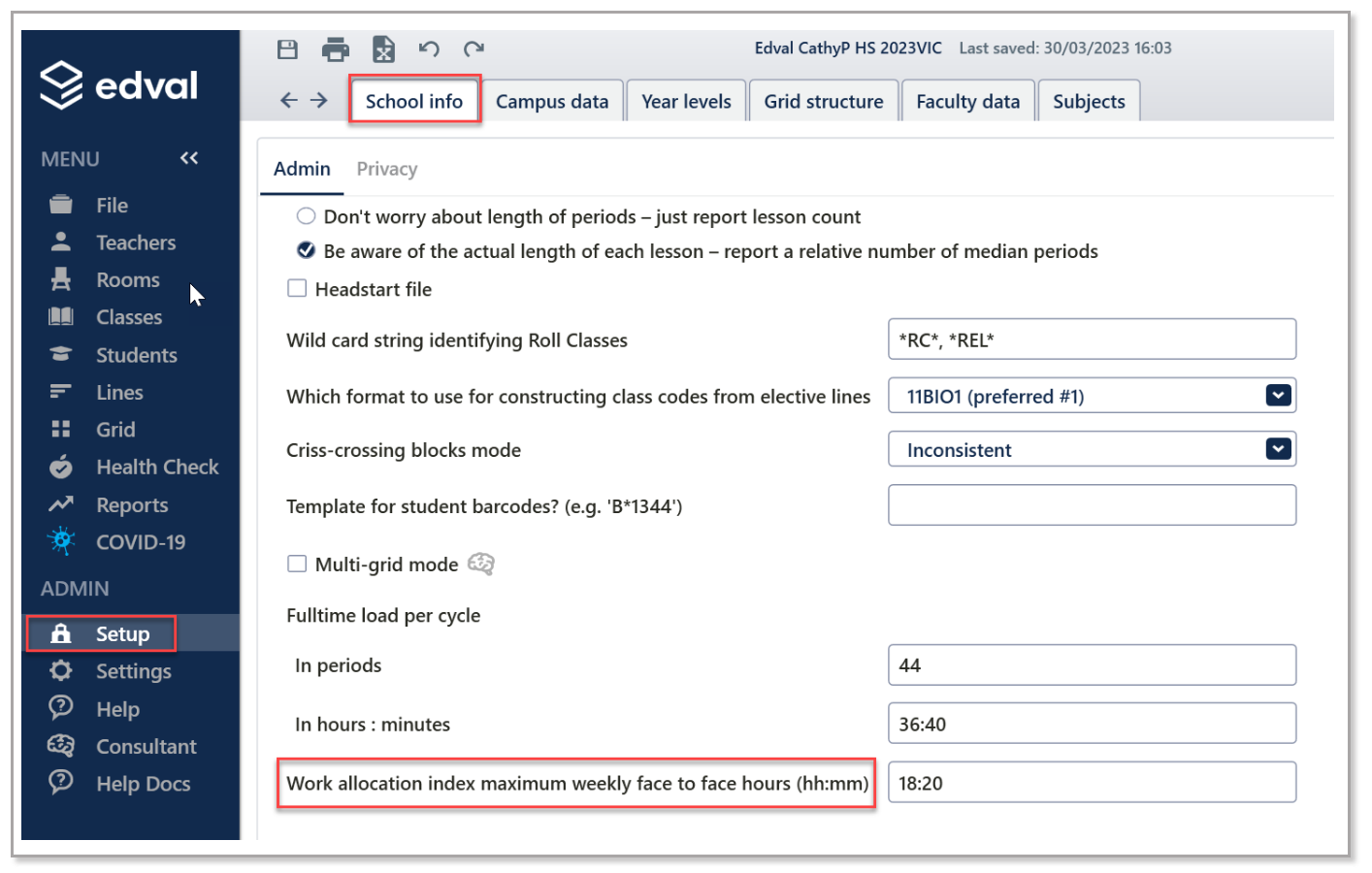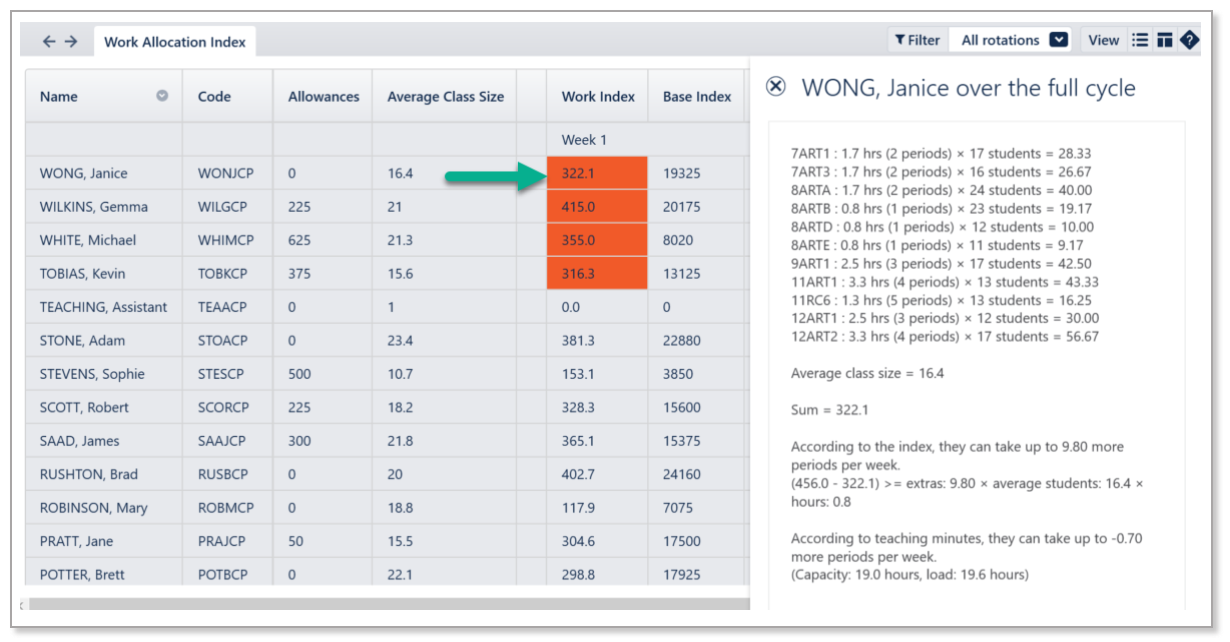TABLE OF CONTENTS
- Setting the maximum number of face to face hours
- Allowances, Index value and calculations
- The Work Allocation report
- Violation explanation
The Work Allocation index (previously known as the 480 index) was agreed by the Victorian Education department and the Australian Education union as the maximum measure of a teacher's work load. Up until 2022, staff could take no more than 20 hours face to face teaching (plus allowances) per week with an average class size of 24 students. Hence 20 x 24 = 480.
 Note: In 2023, the maximum number of face to face hours will be reduced to 19 hours and will be reduced further in 2024 to 18.5 hours. Schools may opt to use the 2024 value in 2023. Due to this, and to accommodate any future changes, we have altered how the Work Allocation report will function in version 10.10.1. Schools can now enter a value for the maximum face to face hours and the report will automatically adjust the index and the resulting maximum number of 'extras' accordingly. In 2023, with a maximum of 19 hours, the index becomes 456 and in 2024, with a maximum of 18.5 hours, the index will become 444. The maximum number of extras per teacher per week will continue to be sent to Edval Daily for allocation of covers.
Note: In 2023, the maximum number of face to face hours will be reduced to 19 hours and will be reduced further in 2024 to 18.5 hours. Schools may opt to use the 2024 value in 2023. Due to this, and to accommodate any future changes, we have altered how the Work Allocation report will function in version 10.10.1. Schools can now enter a value for the maximum face to face hours and the report will automatically adjust the index and the resulting maximum number of 'extras' accordingly. In 2023, with a maximum of 19 hours, the index becomes 456 and in 2024, with a maximum of 18.5 hours, the index will become 444. The maximum number of extras per teacher per week will continue to be sent to Edval Daily for allocation of covers.  Warning: Do not open and save your live etz file in Edval 9.9.933 and earlier if using this feature. Since E9 has a default of 20 hours the new Work allocation index you have entered in Edval10 will revert to 20 if you switch between E9 and E10.
Warning: Do not open and save your live etz file in Edval 9.9.933 and earlier if using this feature. Since E9 has a default of 20 hours the new Work allocation index you have entered in Edval10 will revert to 20 if you switch between E9 and E10. Setting the maximum number of face to face hours
To set the maximum number of face to face hours for teachers, go to Setup > School info and enter the required value in the the 'Work allocation index maximum weekly face to face hours' field. If left blank, the report will use the default original 20 hours. Once a new value is entered, the Work Allocation index report will adjust accordingly. Note that this setting only appears for files with a region of VIC.

Allowances, Index value and calculations
The face to face teaching hours includes any assigned allowances. Allowances are then multiplied by the average class size of that teacher.
The index value is derived by multiplying the teaching time by the number of students, and converting to a weekly figure, so having more students or more classes means more work for the teacher.
The Victorian authorities stipulate no teacher should be working above the index, as this means they are over-worked, and which may also affect teaching quality. The metric is a means to ensure class sizes are not too big, and that teachers are not assigned an unreasonable work load.
The Work Allocation report
This report, found under Reports > Teachers, will show the metric calculated for each teacher. Any instance of the teacher working above the index will be highlighted in pink and any instance of the teacher having exceeded the maximum weekly face to face hours, will be highlighted in orange. Note that part-time teachers have an index value that is calculated pro-rata based on their FTE. The number of extras that each teacher can be allocated per week, based on the index and working hours, is listed in the Num extras column. Note that this value is editable.
In the example below, Tess Manning is under the maximum face to face hours in both weeks and has not breached the index value, which in this case is 24 x 19 = 456. It has been calculated that she can do 4.1 extras in week 1 and 2.1 extras in week 2. Beth Little is over the maximum 19 hours face to face teaching in both weeks and cannot do any extras in either week and is therefore highlighted in orange. Sonia Lee, a part-timer, has breached the index value for her FTE in week 1 and can not do any extras in that week so this has been highlighted in pink. Ellen Lawton has breached the index value due to her large class sizes and allowances and therefore cannot do any extras.

Example of a calculation:
Hypothetically, Mr Jones has been allocated:
- 3 periods of Eng with 8A (24 students),
- 4 periods of literature with Year 11 (26 students),
- 6 periods of Eng with 7A (25 students)
- 3 period allowance as English coordinator.
- 4 periods of literature with Year 11 (26 students),
- 6 periods of Eng with 7A (25 students)
- 3 period allowance as English coordinator.
Each period is 75min, or 1.25 hours. Max teaching hours is 19.
The Work allocation index calculation would be: 3 x 1.25hrs x 24 + 4 x 1.25 x 26 + 6 x 1.25 x 25 + 3 x 1.25 x (24+26+25) / 3 = 501
This means Mr Jones is way over the 456 value and needs to either take classes with fewer students, or lose some of his classes.
Violation explanation
Double click on an orange highlighted cell to view a detailed explanation of the issue.

 The detailed explanation displayed on the slide out does not show classes that are not timetabled yet but they are included in the calculation.
The detailed explanation displayed on the slide out does not show classes that are not timetabled yet but they are included in the calculation.  There are some discrepancies apparent in the values calculated due to the rounding of decimal values in the back end of the program.
There are some discrepancies apparent in the values calculated due to the rounding of decimal values in the back end of the program. Work Allocation index and Edval Daily
Schools using this method will have extras assigned using the Work allocation Index in Edval Daily. For more information on the Work Allocation index and how to implement this in Edval Daily please see this document
Troubleshooting
Q. Daily is showing the incorrect Num extras?
The main reason for this is that in Teacher > Teacher data the FTE is incorrect. Sometimes when teachers change their time fraction schools only update the Maxload and not the FTE.
 Make sure to adjust both the FTE and the MaxLoad as the Daily calculation uses the FTE and not the MaxLoad.
Make sure to adjust both the FTE and the MaxLoad as the Daily calculation uses the FTE and not the MaxLoad. Was this article helpful?
That’s Great!
Thank you for your feedback
Sorry! We couldn't be helpful
Thank you for your feedback
Feedback sent
We appreciate your effort and will try to fix the article